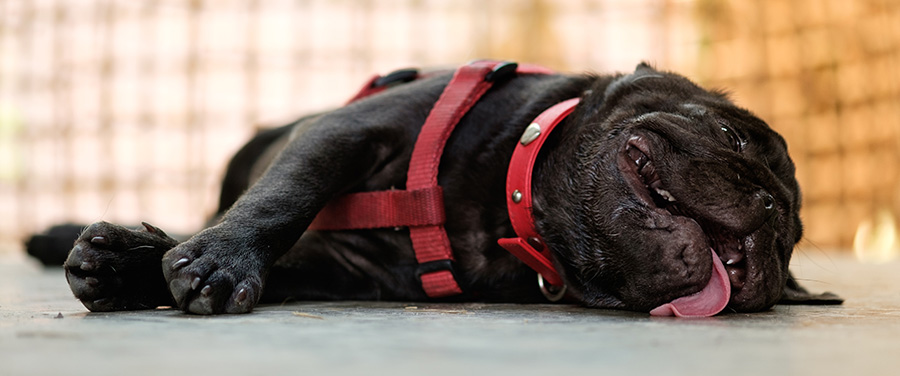Posts in Category: Pet Health & Wellness
Preventatives for Pets

As summer comes to a close, and the cool of fall begins, everyone is preparing for sweaters and pumpkins. With the change of the season, it can be easy to forget that as we gear up for cool weather, pests like ticks and fleas do not. It is important to maintain preventatives for your pet all year round. Let’s review some of the important reasons to keep up on preventatives for your dogs and cats.
Skin Problems
One reason to use prevention against fleas and ticks is because they can cause skin problems for your pet, and your family. The tiny pests can cause irritation of the skin when they bite, leading to itching and redness. In some cases, they can cause a allergic reaction.
The Costs
In addition to irritation, the presence of fleas and ticks can quickly become overwhelming. When fleas and ticks get into your home, they can quickly populate and spread, making them difficult to get rid of. It can be very costly to treat an infestation in your home, and can take more than one treatment because of the varying lifecycle of the little bugs.
On top of this, if your pet is infested, they will also need treatments. This can range from flea dips to topical and oral medications in order to get rid of the pests.
Preventatives Stop Illness
The number one reason for preventatives is to stop the spread of illnesses from fleas and ticks to your pets. There are a variety of illnesses that these small bugs can carry, and spread to your pets and your family. Fleas in the US commonly transfer flea-borne tape worms, cat scratch fever (bartonellosis), murine typhus, and flea-borne spotted fever.
Ticks can spread illnesses such as Lyme disease, anaplasmosis, leptospirosis, Rocky Mountain spotted fever, rickettsiosis, and more. Fleas and ticks spread these illnesses through their bites. The more they bite, the more likely the to infect your pet. Preventatives are designed to lower the chance by killing off fleas and ticks when they get on your pet and try biting them.
Does my pet need preventatives?
The short answer is – Yes! Fleas are small, and move quickly. Ticks can also be easily missed, ranging in size from as small as a poppy seed, to as large as the eraser on a pencil. It can be difficult to find these pets on your pets, especially cats since they groom themselves so often!
Even if your pet is an indoor cat, or a small dog that rarely goes outside – they still need preventatives! All it takes to pick up fleas or ticks, is for you to have them on your clothes when you come inside. Even a brief step outside by your dog to use the bathroom can expose them.
As a result, by the time you notice the presence of fleas or ticks in your home or on your pet, it may already be too late. Veterinarians recommend you keep your pet on preventatives year-round. Here in Minnesota, these pests are present all year.
You can read more about Flea and Tick Prevention from our previous blog. You can look up prevalence of tick and flea borne illness near you checking out the Parasite Prevalence Maps.
Heatstroke in your pet!
By Dr. Maria Krenz, DVM – ZimmVet-763-856-4848

When a dog’s internal body temperature is above 105 degrees F, the dog may be suffering from heatstroke. Dogs have only a couple of ways to cool off—blood vessel expansion and panting. When dogs pant, they evaporate moisture from their tongues, nasal passages, and the lining of their lungs, and this cools them down as air passes over the moist tissue. They also cool off via vasodilation. Blood vessels, especially in the ears and face, expand, bringing overheated blood closer to the surface to cool down.
Signs of Heat Stroke
Heat Stroke in pets! Heatstroke in dogs is life-threatening and can also result in very serious complications. Recognizing early signs of heatstroke may help you remedy the condition before things get too serious. Early signs of heatstroke include:
- Heavy Panting
- Rapid Breathing
- Excessive Drooling
- Dry Mucous Membranes
- Bright red gums and tongue
- Skin that is hot to the touch
- High Heart Rate
Affected dogs become hyperactive and may have difficulty maintaining balance. As exposure to excessive heat goes on, the dog’s condition worsens and includes signs of shock, pale mucous membranes with white or blue gums, a very rapid heart rate, and a drop in blood pressure. The dog hyperventilates, and dehydration becomes more severe. Pupils dilate, the pulse becomes more irregular, and the dog has muscle tremors. They may become lethargic and unwilling to move, urinate or defecate uncontrollably, collapse, and become comatose.
Why Does Heat Stroke Occur?
Heatstroke generally occurs during the hottest part of the year, especially when it is humid. Contributing factors include: breed, age, physical fitness, if a pet is overweight, medical disorders and being in closed conditions such as a car.
How to Treat Heatstroke
Heatstroke therapy involves immediately trying to lower the dog’s body temperature. If you notice signs of heatstroke in your dog, it’s critical to stop any activity and help your dog cool down by:
- Walking or carrying the dog to a well-ventilated, cool area.
- Spraying or sponging the dog with cool (not cold) or tepid water, especially on the underside. Do not immerse the animal in cold water.
- Using a fan to blow cool air on them.
If at home cooling does not bring your dog’s body temperature below 103 degrees bring your dog to your veterinarian or local pet emergency clinic. Severely affected dogs require fluids, medication, support, and oxygen. Complications may not occur immediately, so it’s important to let your veterinarian determine the type of follow-up treatment required.
Conclusion
Heatstroke in Pets! Immediate action and correct treatment are so important because they can mean the difference between a swift and complete recovery and long-term complications.
Always provide plenty of cool fresh water, shade, and frequent rest periods when it’s hot. And never leave your dog in the car.
Please visit the AAHA website at https://www.aaha.org/your-pet/pet-owner-education/ask-aaha/how-can-i-prevent-heatstroke-in-my-pet/ for more information. More information on heatstroke and summer fun with your pet please visit our other blog post https://www.zimmvet.com/blog/wp-admin/post.php?post=885&action=edit.
Canine Influenza
By Dr. Maria Krenz, DVM – ZimmVet-763-856-4848

Canine influenza, or dog flu, has been in the news on and off when outbreaks occur. Recently there was an out break in the Minneapolis, Minnesota area that affected many. Make sure your dog is protected from the flu with the Canine Influenza Vaccination.
Spread of Dog Flu
Dog Flu is spread by direct dog-to-dog contact. The secretions from infected dogs coughing and sneezing can stay on objects and people that healthy pets may come in contact with. The virus is active in the environment for up to 48 hours, however, disinfectants can kill the virus. The flu is not seasonal, but can be contracted year round.
Signs and Treatments
Signs of Dog Flu may be mild to severe, but it can also be deadly. The signs of Dog Flu can look like other respiratory diseases such as kennel cough. Signs of Dog Flu can develop 2-4 days after exposure to an infected dog and illness may last up to 2-3 weeks. Signs can include:
- coughing
- sneezing
- nasal discharge
- eye discharge
- decreased appetite
- lethargy
- Fever
- In severe cases, a secondary bacterial infection can cause pneumonia. These pets have high fevers and trouble breathing.
Treatment includes antibiotics for secondary bacterial infections, fluids for dehydration, medication to reduce fever and nutritional supplements. If you notice any signs of illness, make an appointment with your veterinarian for an examination as soon as possible.
What dogs are at Risk?
Pets that are around other dogs are at higher risk of contracting canine influenza. Examples are pets that stay in a pet hotel, dog daycare, training class, dog parks and grooming facilities. Young and Senior Pets, along with pets that have medical conditions that affect their immune systems, are at higher risk of getting severe forms of the dog Flu.
Vaccination
A vaccination for Dog Flu is available. Dogs have no natural immunity to Dog Flu since it is a newer virus. The current vaccination is for both the H3N8 and H3N2 strains. If this is the first time your dog is getting the vaccination, it will need to be boostered in 3-4 weeks and then given yearly. This vaccination is recommended for dogs that are around other dogs frequently. This vaccination is available at ZimmVet. For more information on vaccines visit https://www.zimmvet.com/blog/canine-vaccine-overview/
In conclusion
As long as the facility you are bringing your pet to have good sanitation methods and protocols for disease outbreaks in place, you do not need to be overly concerned about bringing your pet around other dogs such as a Pet Hotel or Daycare. It is best practice that dog facilities require the flu vaccination to keep dogs healthy. If you are wanting more information you can visit the CDC website https://www.cdc.gov/flu/other/canine-flu/keyfacts.html.
**Disclaimer: This written content is meant to be educational and is not medical advice. Always consult a veterinarian about medical advice for your pet.
Beautiful For You but Toxic To Your Cat!
By: Brook Buckholtz, CSR – Zimmvet (763)856-4848

Lilies are beautiful flowers! They can mean something special when put into a bouquet or could be a statement piece when put into your garden. Unfortunately the problem that arises is that Lilies are extremely toxic to cats, even one sniff could send them to the emergency clinic or be fatal. So if you want to ensure that your furry friends stay safe make sure you keep lilies out of your house and garden! Remember they are beautiful to you but toxic to your cat!
Signs of Lilly Toxicity:
Every part of the lily flower is toxic to cats. The pollen, the leaves, the flower itself and the stems. If you have lilies in a bouquet in your home even the water the lily plant sits in can cause severe damage to your pet. The best way to avoid this from happening is to keep lilies out of your house and garden if you have a cat.
Kidney failure can happen very quickly in cats that come in contact with Lilies. If you know that your cat has come in contact with Lilies seek veterinary care immediately. Signs of early toxicity include but are not limited to:
- Decrease activity level
- Drooling
- Vomiting
- Loss of appetite
- Increase urination
- Dehydration
Conclusion
Remember lilies are so toxic to cats that even just one sniff can cause them serious medical problems or even death. The best way to prevent this from becoming a problem is to keep lilies out of your home and garden. If you think your cat has come into contact with the lily plant seek veterinary care immediately! Below is a link to the FDA website which has more information on lily toxicity.
For more information please visit the FDAs webpage on Lily Toxicity in cats at https://www.fda.gov/animal-veterinary/animal-health-literacy/lovely-lilies-and-curious-cats-dangerous-combination#:~:text=The%20entire%20lily%20plant%20is,in%20less%20than%203%20days.
If you are considering adding new plants to your house or garden make sure to do your research! This blog post goes over some safe and unsafe house plants to pets. https://www.zimmvet.com/blog/house-plants-and-pets-2/
Leptospirosis a risk to Pets and People!
By Dr. Maria Krenz, DVM – ZimmVet-763-856-4848

Leptospirosis (Lepto) is an infectious disease and can cause serious illness in dogs and people. This disease is from a spiral-shaped bacteria called Leptospira which live in water or warm wet soil. Any type of animal can potentially get infected. In fact, this has been a problem for years but is now more prevalent; which means Leptospirosis is a risk to all!
How Pets and People get Infected
Lepto is spread through bacteria in the urine of the infected animals. Humans and animals can potentially become infected through skin, bodily fluids (except for saliva), and mucus membranes (such as eyes, nose, and/or mouth). Dogs can pass the disease to each other as well as to people.
Lepto has become more problematic with the increase in development in areas that were once rural. As a result, pets may be exposed to more wildlife such as raccoons, skunks, squirrels, opossums, or deer that have been infected with the disease. In the event that your pet does become infected, it could mean that your pet may have been drinking, swimming, or walking through the contaminated water or soil.
Signs and Symptoms
The signs can vary and are nonspecific. However, some pets do not have any symptoms.
- Common signs to list that have been reported in dogs are:
- Fever
- Vomiting
- Abdominal Pain
- Diarrhea
- Refusing to eat
- Severe weakness
- Depression
- Stiffness
- Severe muscle pain
- Inability to have puppies
- Younger dogs (less than 1 year of age) tend to get the most severe forms of the disease.
- 87-100% of dogs that have been infected will have some degree of kidney dysfunction.
Treatment
The disease is treated with an antibiotic. More often than not pets will need other supportive treatments. Unfortunately, in some cases the disease has caused too much damage to the pet’s liver and kidneys which means the pet doesn’t recover.
Prevention
- Firstly, vaccinating your pet is key in preventing the infection for your dog. See below link for more information on vaccines.
- Second of all, the American Animal Hospital Associations guidelines recommend the vaccination for all dogs regardless of lifestyle!
- Unfortunately, there is no current vaccination for cats.
- The vaccination is often combined with the distemper which is considered a combination vaccine. The vaccine is administered yearly.
If your pet is diagnosed, make sure that you avoid contact with their urine. During this time, if your pet has an accident in the house ensure you wear gloves and clean well with disinfectant. Lastly, make sure you wash your hands!
In conclusion it is recommended that you vaccinate your pet; no matter what lifestyle you and your pet live! That way you can both continue to live a happy and healthy life.
CDC Fact Sheet: https://www.cdc.gov/leptospirosis/pets/index.html
Disclaimer: This written content is meant to be educational and is not medical advice. Always consult a veterinarian about medical advice for your pet.


